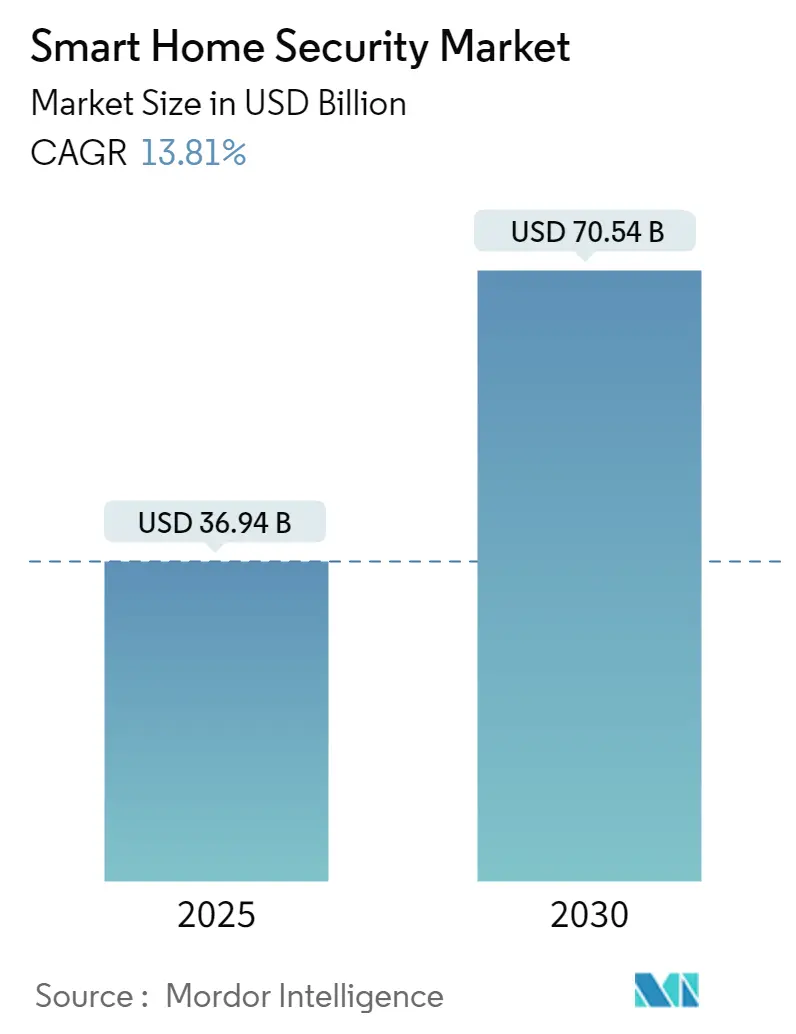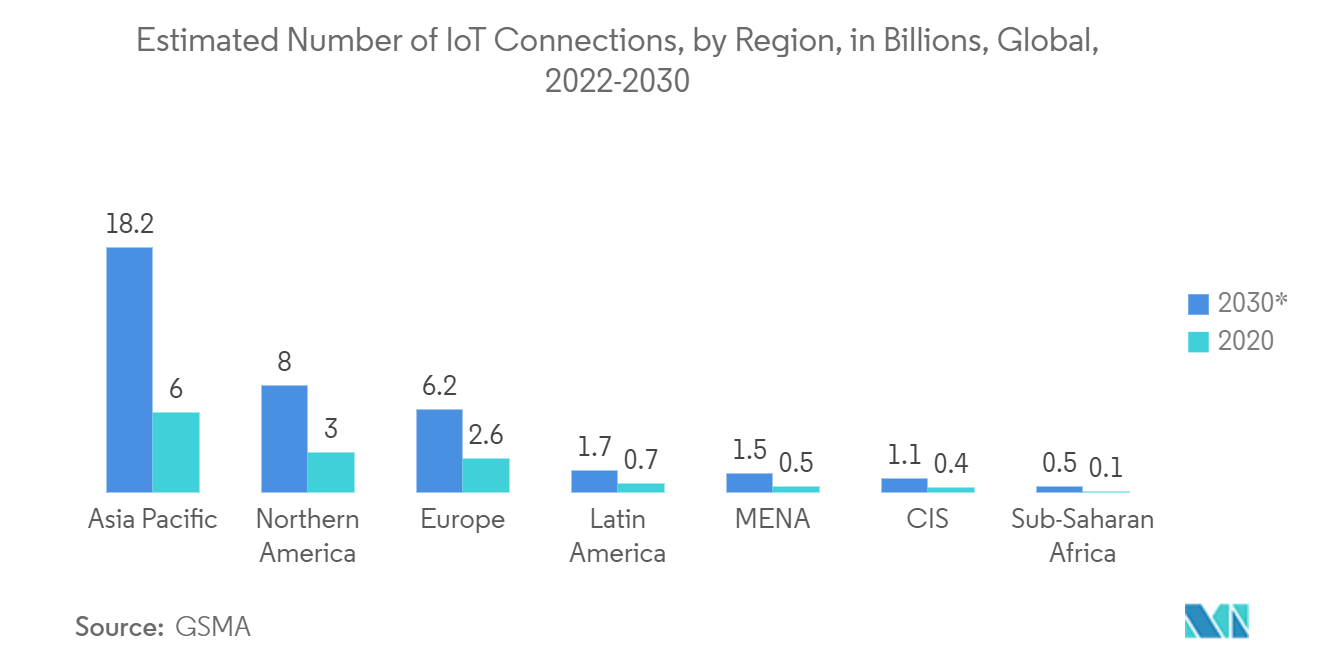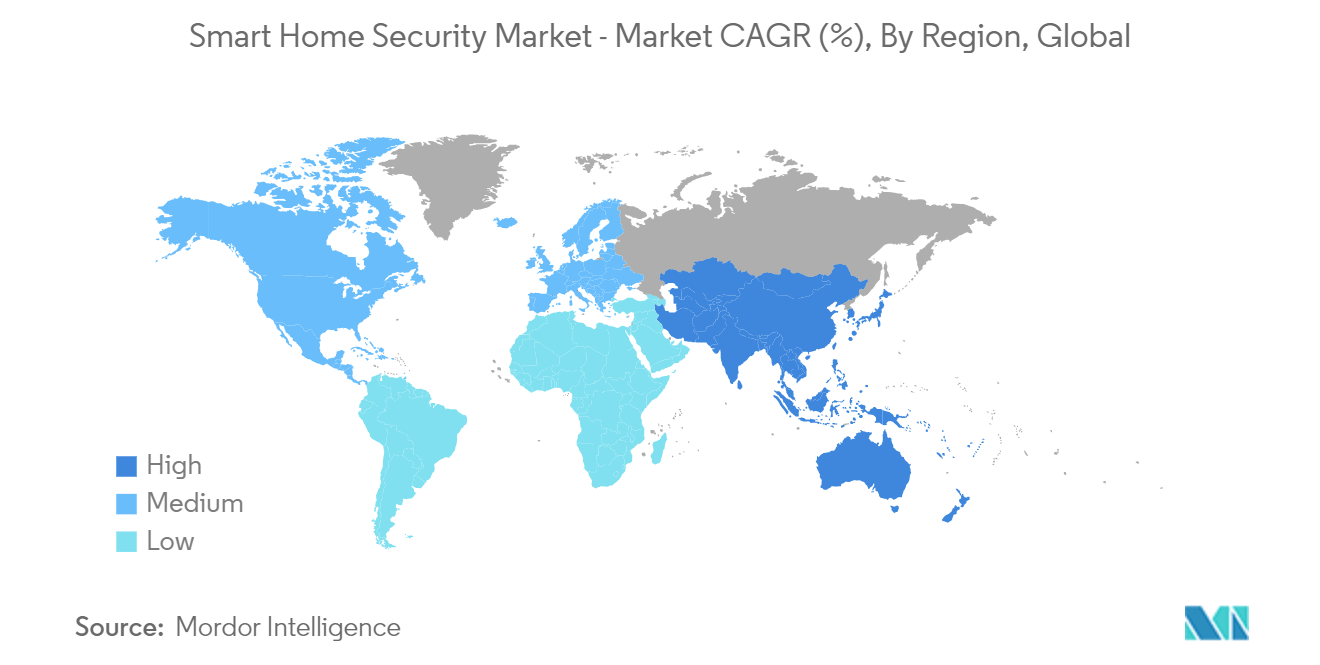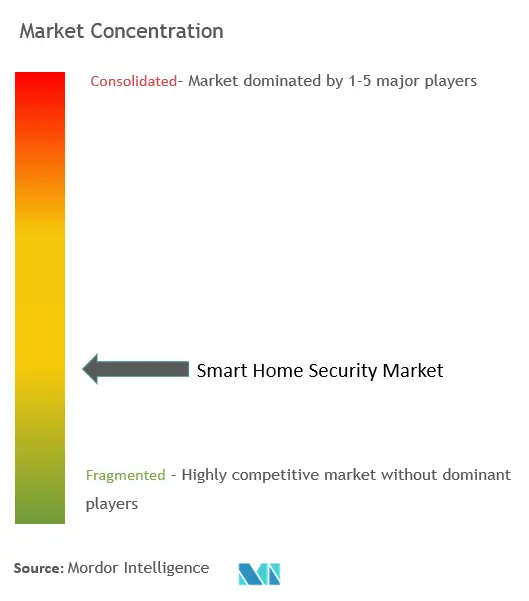Smart Home Security Market Size
Smart Home Security Market Analysis
The Smart Home Security Market size is estimated at USD 36.94 billion in 2025, and is expected to reach USD 70.54 billion by 2030, at a CAGR of 13.81% during the forecast period (2025-2030).
The rising number of internet users, rapidly growing adoption of smartphones and smart gadgets, and the increasing concern about remote house monitoring are the key factors driving the growth of smart home security market. Furthermore, rising crime rates around the world are fueling industry growth.
- The introduction of IoT and favorable policies created a solid basis for the smart home security market. By 2025, the GSMA predicts that China will likely account for around 4.1 billion IoT connections or about one-third of all IoT connections worldwide. In addition, programs like the Made in China 2025 strategy, the National New-type Urbanization Plan, and the Smart Cities Projects are anticipated to drive the growth of China's smart home security market. Most companies and vendors in China compete to stay dominant in the market as the overall demand for the installation of AI-powered security cameras in homes is growing massively, offering homeowners greater security features, such as timely intruder alarms or notifications when their loved ones arrive home.
- According to Bunning's study, a prominent home improvement retailer and outdoor living products in Australia and New Zealand, smart home technology is growing in Australia, with around 49% of the population now having some form of this technology. The company's study also uncovered that 1 in 2 Australians use their smart home technology daily, with general security (61%) and protection against intruders (44%) the most significant drivers for uptake. Security camera systems are the biggest mover in the space, with Bunning's study predicting that most Australians would install some security device in their home in the next five years. However, with the numerous benefits of smart home security products, they could leave homeowners more vulnerable to digital threats, and these devices are potential points of entry for cybercriminals who wish to access personal data. These concerns are challenging the market growth.
- Moreover, Google Assistants and Amazon Alexa are compatible with home security systems. Thermostats, smart locks, cameras, doorbells, wall-mounted touchscreen displays, smartphone apps, Google Assistants, and Alexa are all integrated into home security systems, in addition to others. The connectivity between these devices allows for constant home security. Including additional features such as carbon monoxide (CO) listeners, flood and freezing alarms, and other recent technologically enhanced security systems expands the potential for new markets for smart home security systems. Furthermore, Z-Wave-compatible smart home alarm systems use Wi-Fi-enabled cameras to monitor homes using sound detection and panoramic videos.
- The Covid-19 pandemic significantly negatively affected the expansion of the worldwide home security systems industry. Due to production hiccups and temporary transportation system shutdowns, global sales declined precipitously during that period. The supply chain interruption in China caused a sharp fall in demand for home security systems, severely impacting key markets worldwide. Some reasons affecting demand in China include the drop in new development projects and the closure of production plants. However, as the market recovers in 2021, the US and China are expected to re-emerge as major countries in the home security systems market.
Smart Home Security Market Trends
Smart Camera and Monitoring Segment to Witness Significant Growth
- Surveillance systems have gained considerable market traction in the recent past. The residential societies and different homeowners use these systems to check on various activities for safety and security purposes. Advanced intelligent surveillance systems (AISS) are replacing traditional surveillance systems. The latter is used to identify abnormal behavior and patterns via artificial intelligence technologies, pattern recognition, and computer vision.
- This, in turn, enables high-accuracy monitoring of multiple scenarios by a few observers. Over the past few years, the video surveillance market has significantly transformed into third-generation video surveillance systems, moving to IP video from traditional analog video causing better processing power and improved compression algorithm. Further, smart home monitoring solutions are designed and implemented using emerging technologies, such as the Internet of Things (IoT). The growing use of IoT offers functions like electric control, environmental monitoring, indoor monitoring, abnormal alarm, historical information query, and many more.
- Over the last few years, the adoption of IP cameras has increased owing to the growing demand for crisp image resolution and perimeter surveillance. The critical technologies adopted worldwide include CCTVs, command & control, private LTE communications, data storage, ANPR (automatic number plate recognition), video analytics, and supporting ICT equipment. These technologies have promoted the adoption of smart cameras and monitoring systems.
- The smart home cameras and surveillance systems in the current marketplace can record HD videos and images at 1080x720 pixels for superior resolution. The camera is triggered when sounds or motions are detected. Also, two-way communication is possible via the camera as two-way speaking and listening are enabled.
- According to the Federation of Indian Chambers of Commerce & Industry, the total number of constructed dwellings in India's metropolitan areas under the Pradhan Mantri Awas Yojana (PMAY, The Prime Minister's Housing Plan) reached 5.4 million in 2022. The program, which began in 2015, mostly consists of housing complexes. In 2020, the need for housing facilities for the urban poor was expected to be over 11 million dwelling units.
North America is Expected to Hold Major Share
- The United States is the prominent market in the North American region, owing to the growing adoption of smart home technology and products. According to the National Council for Home Safety and Security (Alarms.org) study, more than 3 in five Americans claim security is the top benefit of owning a smart home. Also, 57% of Americans stated that smart home technology products could save an average of 30 minutes daily.
- According to New-Gen Apps, "The United States of America was able to conserve energy and reduce household consumption by 20% just by introducing smart homes and sensors." Furthermore, Thales Group's statistics state that 63 million U.S. households will have a home security system by 2024. Such growth prospectus is expected to drive the market's growth in the country.
- Owing to the growing need for households to purchase smart locks as part of home security or home control system, companies in the market are developing partnerships. For instance, in June 2023, Volt, a smart home solutions provider, became a strategic partner with Ring, an Amazon company, as a preferred Ring dealer. This collaboration will likely give Volt customers enhanced access to Ring’s popular smart home security products, such as video doorbells and security cameras. With this partnership, Volt aims to strengthen its position to meet the increasing demand for advanced home security systems in the market.
- As many consumers are opting to install do-it-yourself (DIY) smart home security systems, recent trends show continued strength in professional installation services in the United States market, primarily driven by remote workers' connected tech needs. As a result, companies are started selling smart home security packages in the United States. For instance, in February 2023, ADT partnered with Costco to offer packages that include 9-piece system and a 13-piece system, both of which include Google Nest products. These packages also include professional installation and ADT's award-winning SMART monitoring.
- In October 2022, EZVIZ, a global smart home security company, launched its all-star lineup of battery-powered smart products for the Canadian market, including the DB2 Battery Doorbell Kit and CP4 Battery Door, Viewer. The DB2 Doorbell and CP4 Door Viewer are wireless for hassle-free setup and use. The easy installation and usage of home security appliances are driving the growth of Canada's smart home security market.
Smart Home Security Industry Overview
The smart home security market is highly fragmented due to low entry barriers. The major players in the market are ADT Inc., Honeywell International Inc., Johnson Controls International PLC, Hangzhou Hikvision Digital Technology Co. Ltd, and Abode Systems Inc., among others. Further strategic partnerships and innovations are the driving force for the industry, and the market is evolving faster in terms of technology and features.
- July 2023 - Versuni, formerly known as Philips domestic appliances, has expanded into home safety products. The company launched its first-ever smart home security camera range in India, including three smart security cameras and a new Home Safety App. These new cameras help reduce false alarms, provide accurate alerts, and offer 24/7 control that allows viewing, recording, and responding to security events from anywhere.
- June 2023 - Volt, a smart home solutions provider, formed a strategic partnership with Ring, an Amazon company, as a preferred Ring dealer. With this collaboration, Volt will get customers enhanced access to Ring’s popular smart home security products, such as video doorbells and security cameras.
- March 2023 - ADT Inc., among the most trusted brands in smart home and small business security, made available the new ADT Self Setup Smart Home Security System, which is the most advanced and complete DIY system and the first fully integrated DIY offering from ADT and Google. The new system integrates Google Nest smart home products with ADT security and life safety technology as well as ADT SMART Monitoring with the convenient control of the new ADT+ app.
Smart Home Security Market Leaders
-
ADT Inc.
-
Honeywell International Inc.
-
Johnson Controls International PLC
-
Hangzhou Hikvision Digital Technology Co. Ltd
-
Abode Systems Inc.
- *Disclaimer: Major Players sorted in no particular order
Smart Home Security Market News
- April 2023 - Apple has been awarded a patent (US 11,619,991 B2) for software that would give its HomePod digital assistant the ability to understand a recognized person’s voiced instruction and facial signals as a single command. Simultaneously, Aqara, a new startup introduced its video doorbell, which has facial recognition and can disguise a home occupant’s voice when conversing remotely with someone at the door.
- December 2022 - Alarm.com has released Smart Arming, a new feature that intelligently arms and disarms Alarm.com powered home security systems based on user activity. Users select the time of day they generally want their system armed at night (e.g., after 11 p.m.), disarmed in the morning (e.g., at 7 a.m.), and then go about their regular routines.
Smart Home Security Industry Segmentation
Smart home security employs IoT-enabled gadgets to enable customers to monitor and manage their home's security, including door access and surveillance. Smart home security uses an assortment of IoT-enabled technologies to enable consumers to monitor and manage the security of their houses remotely.
The smart home security market is segmented by component (hardware, software, services), device type (smart alarms, smart locks, smart sensors and detectors, smart camera and monitoring systems), communication module (professionally monitored, self-monitored), and geography (North America, Europe, Asia Pacific, Latin America, Middle East and Africa). The market sizes and forecasts are provided in terms of value (USD) for all the above segments.
| By Component | Hardware | ||
| Software | |||
| Services | |||
| By Device Type | Smart Alarms | ||
| Smart Locks | |||
| Smart Sensors and Detectors | |||
| Smart Camera and Monitoring System | |||
| Other Device Types | |||
| By Communication Module | Professional Monitored | ||
| Self Monitored | |||
| By Geography | North America | United States | |
| Canada | |||
| Europe | Germany | ||
| United Kingdom | |||
| Norway | |||
| Denmark | |||
| Rest of Europe | |||
| Asia-Pacific | China | ||
| Japan | |||
| South Korea | |||
| Rest of Asia-Pacific | |||
| Latin America | Mexico | ||
| Brazil | |||
| Rest of Latin America | |||
| Middle East and Africa | United Arab Emirates | ||
| Saudi Arabia | |||
| South Africa | |||
| Rest of Middle East and Africa | |||
Smart Home Security Market Research Faqs
How big is the Smart Home Security Market?
The Smart Home Security Market size is expected to reach USD 36.94 billion in 2025 and grow at a CAGR of 13.81% to reach USD 70.54 billion by 2030.
What is the current Smart Home Security Market size?
In 2025, the Smart Home Security Market size is expected to reach USD 36.94 billion.
Who are the key players in Smart Home Security Market?
ADT Inc., Honeywell International Inc., Johnson Controls International PLC, Hangzhou Hikvision Digital Technology Co. Ltd and Abode Systems Inc. are the major companies operating in the Smart Home Security Market.
Which is the fastest growing region in Smart Home Security Market?
Asia-Pacific is estimated to grow at the highest CAGR over the forecast period (2025-2030).
Which region has the biggest share in Smart Home Security Market?
In 2025, the North America accounts for the largest market share in Smart Home Security Market.
What years does this Smart Home Security Market cover, and what was the market size in 2024?
In 2024, the Smart Home Security Market size was estimated at USD 31.84 billion. The report covers the Smart Home Security Market historical market size for years: 2019, 2020, 2021, 2022, 2023 and 2024. The report also forecasts the Smart Home Security Market size for years: 2025, 2026, 2027, 2028, 2029 and 2030.
Our Best Selling Reports
Smart Home Security Industry Report
The Smart Home Security Market is experiencing significant growth, driven by advancements in hardware, software, and services. The market overview highlights the increasing adoption of smart alarms, locks, sensors, detectors, and camera monitoring systems. Industry reports indicate a robust market forecast with a positive industry outlook.
Market leaders are focusing on enhancing communication modules, with both professionally monitored and self-monitored systems gaining traction. The market segmentation by geography reveals that North America, Europe, Asia Pacific, Latin America, and the Middle East and Africa are all contributing to the market value.
Industry analysis shows a promising growth rate, supported by comprehensive market research and market data. The industry size and market size are expanding, with market trends pointing towards increased consumer interest in smart home security solutions. The market report provides an in-depth market review and market analysis, offering valuable insights into market growth and market predictions.
Industry statistics and industry information from research companies underline the importance of staying updated with the latest industry trends. The market forecast and market outlook suggest continuous growth, driven by innovative industry research and industry sales strategies.
The report example and report PDF are available for further insights, providing a detailed market overview and highlighting the strategic moves of market leaders. The industry research emphasizes the importance of understanding market segmentation and market value to capitalize on emerging opportunities in the smart home security market.







